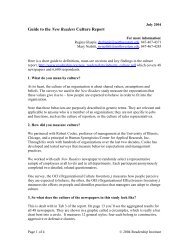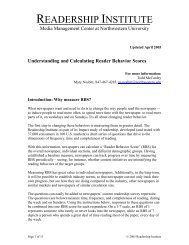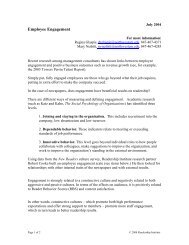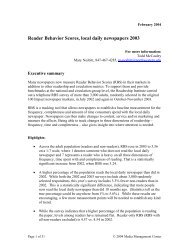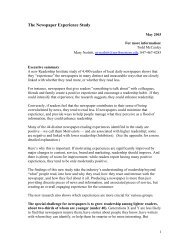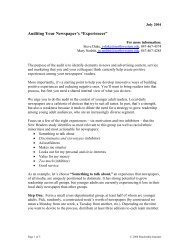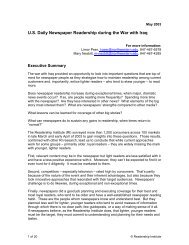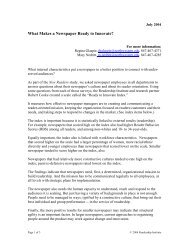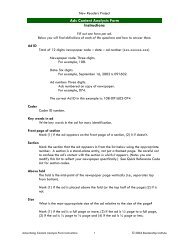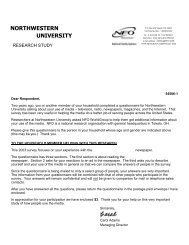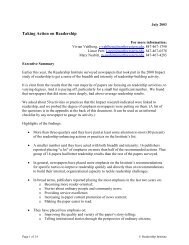Notes on the New Readers Study - Readership Institute
Notes on the New Readers Study - Readership Institute
Notes on the New Readers Study - Readership Institute
Create successful ePaper yourself
Turn your PDF publications into a flip-book with our unique Google optimized e-Paper software.
April 21, 2004<br />
Mary Nesbitt, <strong>Readers</strong>hip <strong>Institute</strong><br />
m-nesbitt@northwestern.edu<br />
847-467-4285<br />
<str<strong>on</strong>g>Notes</str<strong>on</strong>g> <strong>on</strong> <strong>the</strong> <strong>New</strong> <strong>Readers</strong> <strong>Study</strong><br />
Background<br />
Since 1999, <strong>the</strong> newspaper industry has supported new research to help it grow<br />
readership. The work, which also includes teaching <strong>the</strong> research findings and <strong>the</strong>ir<br />
applicati<strong>on</strong> throughout <strong>the</strong> industry, is d<strong>on</strong>e by <strong>the</strong> <strong>Readers</strong>hip <strong>Institute</strong> at Northwestern<br />
University in Evanst<strong>on</strong>, Illinois and funded by <strong>the</strong> <strong>New</strong>spaper Associati<strong>on</strong> of America<br />
(NAA), <strong>the</strong> American Society of <strong>New</strong>spaper Editors (ASNE) and <strong>the</strong> McCormick<br />
Tribune Foundati<strong>on</strong>.<br />
The Impact study, c<strong>on</strong>ducted in 2000 with 100 local daily newspapers, identified four<br />
large drivers of general readership – c<strong>on</strong>tent, service, brand and internal culture.<br />
The <strong>New</strong> <strong>Readers</strong> study, c<strong>on</strong>ducted in 2003-04 in 52 markets, focuses <strong>on</strong> younger adults,<br />
who are <strong>the</strong> most diverse populati<strong>on</strong> segment. It is a widely held myth that young adults<br />
will naturally and inevitably pick up <strong>the</strong> newspaper habit as <strong>the</strong>y age. On <strong>the</strong> c<strong>on</strong>trary,<br />
research over several decades shows that people do not read more as <strong>the</strong>y age; in fact<br />
<strong>the</strong>y read less. In additi<strong>on</strong>, aging cohorts of heavy readers are being replaced by people<br />
who read at a significantly lower level.<br />
What can newspapers do to engage younger adults? How do we get inside <strong>the</strong>ir heads to<br />
understand <strong>the</strong>ir experiences – including <strong>the</strong>ir thoughts and feelings associated with <strong>the</strong><br />
newspaper – so that we can figure out ways to engage <strong>the</strong>m more? That is <strong>the</strong> purpose of<br />
<strong>New</strong> <strong>Readers</strong>.<br />
It is important to note that newspapers still reach a significant proporti<strong>on</strong> of younger<br />
adults. For instance, <strong>the</strong> <strong>Institute</strong>’s 2003 nati<strong>on</strong>al Reader Behavior Score (RBS) study<br />
found that while 18-24 year olds are less likely to read than <strong>the</strong>ir older counterparts, 61%<br />
read <strong>the</strong>ir local daily newspaper over <strong>the</strong> course of a typical week. Sunday is <strong>the</strong> day<br />
most likely to be read, and those who do read spend about 50 minutes with it. Their<br />
average weekday reading time is about 20 minutes. They tend to be selective in what <strong>the</strong>y<br />
read, looking at less than half of <strong>the</strong> Sunday paper and less than <strong>on</strong>e-third of <strong>the</strong> weekday<br />
paper.<br />
Older readers – especially those over 65 – have more robust usage patterns. The c<strong>on</strong>cern<br />
is that given <strong>the</strong> trends referenced above, current older and heavier readers will be<br />
replaced by generati<strong>on</strong>s that lack a str<strong>on</strong>g newspaper-reading habit.<br />
1
<strong>Study</strong> Method<br />
<strong>New</strong> <strong>Readers</strong> focuses <strong>on</strong> <strong>the</strong> readers of 52 local daily newspapers (see last page.) Most of<br />
<strong>the</strong> newspapers were chosen from markets in which <strong>the</strong> target demographics of<br />
race/ethnicity are abundantly present.<br />
(Please note this should not be called a nati<strong>on</strong>al study. Although it is a huge study, it is<br />
not a random sample of newspapers that, toge<strong>the</strong>r, represent <strong>the</strong> industry as a whole. That<br />
was <strong>the</strong> Impact model, which looked at a representative cross-secti<strong>on</strong> of local daily<br />
newspapers and general readership; by c<strong>on</strong>trast, <strong>New</strong> <strong>Readers</strong> looks at how specific<br />
groups of readers experience <strong>the</strong>ir local daily newspaper.)<br />
We focused <strong>on</strong> readers (as opposed to a mix of readers and n<strong>on</strong>-readers) for several<br />
reas<strong>on</strong>s:<br />
• They already have some c<strong>on</strong>necti<strong>on</strong> with <strong>the</strong>ir local daily newspaper. If <strong>the</strong> level<br />
of engagement can be increased, light readership can be moved to moderate, and<br />
moderate to heavy.<br />
• Current readers are a newspaper’s best marketers in terms of bringing in o<strong>the</strong>rs<br />
like <strong>the</strong>m to <strong>the</strong> newspaper.<br />
• <strong>Study</strong>ing readers allows us to relate what <strong>the</strong>y experience, think and feel about<br />
<strong>the</strong>ir local daily newspaper to a quantitative analysis of what is actually in <strong>the</strong><br />
newspaper.<br />
<strong>New</strong> <strong>Readers</strong> ga<strong>the</strong>red data from <strong>the</strong> following areas:<br />
1. The C<strong>on</strong>sumer/Reader<br />
We collected informati<strong>on</strong> <strong>on</strong> <strong>the</strong>ir newspaper usage; <strong>the</strong>ir thoughts and feelings<br />
associated with <strong>the</strong> newspaper (experience); preferences and satisfacti<strong>on</strong> with c<strong>on</strong>tent<br />
(editorial and advertising) and service; <strong>the</strong>ir use of <strong>the</strong> newspaper’s website. Detailed<br />
questi<strong>on</strong>naires were completed by 10,800 resp<strong>on</strong>dents. This represents a 55 percent<br />
resp<strong>on</strong>se rate to <strong>the</strong> surveys fielded.<br />
2. The C<strong>on</strong>tent of <strong>the</strong> newspaper<br />
We analyzed 33,000 stories and photos; 12,000 ads; 21,000 in-paper c<strong>on</strong>tent promoti<strong>on</strong>s.<br />
3. Workforce Demographics and <strong>New</strong>spaper Culture<br />
We c<strong>on</strong>ducted a census of employees in every newspaper department, by race, gender<br />
and level in <strong>the</strong> organizati<strong>on</strong>. On a sampled basis, we c<strong>on</strong>ducted organizati<strong>on</strong>al culture<br />
surveys in every department and at all levels. More than 6,600 employees resp<strong>on</strong>ded to<br />
<strong>the</strong> surveys.<br />
2
Recommendati<strong>on</strong>s to <strong>the</strong> industry<br />
The study identifies many opportunities to engage under-served audiences – if<br />
newspapers are prepared to do three things:<br />
• Get into <strong>the</strong> heads of younger and diverse readers; understand how <strong>the</strong>y live and<br />
what hot-butt<strong>on</strong> “experiences” to push.<br />
• Move from “tweaking around <strong>the</strong> edges” or incremental improvement, to real<br />
innovati<strong>on</strong>.<br />
• Build an organizati<strong>on</strong> that focuses <strong>on</strong> readership, rewards growth and practices<br />
c<strong>on</strong>tinuous innovati<strong>on</strong>.<br />
Details behind <strong>the</strong> recommendati<strong>on</strong>s<br />
What experiences are<br />
<strong>New</strong>spapers do more than just transmit news and informati<strong>on</strong> – <strong>the</strong>y appeal to, trigger<br />
and create experiences, for better or for worse, in c<strong>on</strong>sumers. In today’s envir<strong>on</strong>ment,<br />
with a multiplicity of media choices, readers are not passive recipients. Influenced by<br />
<strong>the</strong>ir backgrounds, pers<strong>on</strong>ality, motivati<strong>on</strong>s, interests and so <strong>on</strong>, <strong>the</strong>y resp<strong>on</strong>d, react to<br />
and interact with what <strong>the</strong> newspaper provides (editorial and ad c<strong>on</strong>tent) and how it’s<br />
provided (service and marketing).<br />
This, in turn affects how much <strong>the</strong>y use <strong>the</strong> newspaper – readership, or as we measure it,<br />
Reader Behavior Scores. (RBS measures frequency of reading, time spent with <strong>the</strong><br />
newspaper and completeness of reading, <strong>on</strong> weekdays and <strong>on</strong> Sundays.)<br />
So it is imperative to understand how readers, and different groups of readers, experience<br />
<strong>the</strong> local daily newspaper – to get inside <strong>the</strong>ir heads and understand <strong>the</strong>ir hot (and cold)<br />
receptors. <strong>New</strong>spapers can <strong>the</strong>n work to enhance <strong>the</strong> experiences that are linked with<br />
str<strong>on</strong>ger reading, and minimize <strong>the</strong> experiences that depress it.<br />
The <strong>New</strong> <strong>Readers</strong> study identifies about 30 experiences that offer <strong>the</strong> most potential for<br />
readership growth. We’ve narrowed that list to <strong>the</strong> eight that could make <strong>the</strong> greatest<br />
difference with <strong>the</strong> target groups.<br />
Fur<strong>the</strong>r, we link <strong>the</strong> experiences with <strong>the</strong> current characteristics of advertising and<br />
editorial c<strong>on</strong>tent. In o<strong>the</strong>r words, we can tell you what it is that newspapers do now that<br />
tends to create more motivating experiences in <strong>the</strong>ir readers. At <strong>the</strong> same time we cauti<strong>on</strong><br />
that it’s not enough just to do more of <strong>the</strong> same. That approach al<strong>on</strong>e will not realize <strong>the</strong><br />
full potential of what understanding and acting <strong>on</strong> <strong>the</strong> c<strong>on</strong>sumer’s “experience” could<br />
bring. Innovati<strong>on</strong> is critical.<br />
3
Experience isn’t a c<strong>on</strong>cept we invented. It is a powerful, c<strong>on</strong>sumer-based reality that<br />
matters to newspapers in some very important, practical ways:<br />
• It is str<strong>on</strong>gly correlated with readership.<br />
• It is a better predictor of readership than c<strong>on</strong>tent satisfacti<strong>on</strong>.<br />
• Str<strong>on</strong>g motivating experiences in newspapers increase <strong>the</strong> effectiveness of<br />
advertising c<strong>on</strong>tent; inhibiting experiences decrease its effectiveness.<br />
• It requires newspapers to really get inside c<strong>on</strong>sumers’ heads before using <strong>the</strong><br />
levers of c<strong>on</strong>tent, service and marketing. It should inform how those levers are<br />
used.<br />
We identified about 30 reader experiences that cut across all readers. In o<strong>the</strong>r words,<br />
every<strong>on</strong>e has <strong>the</strong>m to a greater or lesser degree. Since that is a daunting number to tackle,<br />
we have winnowed <strong>the</strong>m down to eight initial possibilities.<br />
The criteria used to make <strong>the</strong> cut:<br />
• Does <strong>the</strong> experience offer an opportunity for general readership and for <strong>the</strong> target<br />
groups?<br />
• Does it offer practical, c<strong>on</strong>crete opportunities to make incremental and stretch<br />
(innovative) improvements?<br />
• Could innovati<strong>on</strong>s around <strong>the</strong> experience have a positive effect <strong>on</strong> o<strong>the</strong>r<br />
experiences?<br />
• Does it have applicati<strong>on</strong> to service and advertising, as well as news c<strong>on</strong>tent?<br />
Each experience below has a shorthand label, followed by <strong>the</strong> actual c<strong>on</strong>sumer<br />
feelings/reacti<strong>on</strong>s that factored toge<strong>the</strong>r to make up each experience.<br />
Something to talk about (motivator)<br />
I like to talk about <strong>the</strong> nati<strong>on</strong>al news and current events I read about in it.<br />
I bring up things I’ve read in this newspaper in c<strong>on</strong>versati<strong>on</strong>s with many o<strong>the</strong>r<br />
people.<br />
I like to give advice and tips to people I know based <strong>on</strong> things I’ve read in this<br />
newspaper.<br />
I show things in <strong>the</strong> newspaper to people in my family.<br />
Part of my role am<strong>on</strong>g friends or family is to keep <strong>the</strong>m informed because I read<br />
<strong>the</strong> newspaper.<br />
Makes me smarter (motivator)<br />
Even if I disagree with things in this newspaper, I feel like I have learned<br />
something valuable.<br />
It shows me how o<strong>the</strong>r people live <strong>the</strong>ir lives.<br />
I look at <strong>the</strong> newspaper as educati<strong>on</strong>al. I gain something.<br />
This newspaper is good at telling stories about things that happen and how <strong>the</strong>y<br />
turn out.<br />
This newspaper has columns that give good advice.<br />
It is a way to learn about new products.<br />
I learn about things to do or places to go.<br />
4
Value for my m<strong>on</strong>ey (motivator)<br />
Even if this newspaper cost twice as much as it does now, I would still read it.<br />
The newsstand price could probably be higher and sales would be <strong>the</strong> same.<br />
Overall, this newspaper provides pretty good value for <strong>the</strong> m<strong>on</strong>ey.<br />
I save more m<strong>on</strong>ey from its ads and coup<strong>on</strong>s than I spend <strong>on</strong> <strong>the</strong> paper.<br />
Looks out for my pers<strong>on</strong>al and civic interests (motivator)<br />
Reading this newspaper adds to my enjoyment of o<strong>the</strong>r things I do.<br />
People would be better parents if <strong>the</strong>y read this newspaper.<br />
I think people who do not read this newspaper or <strong>on</strong>e like it are really at a<br />
disadvantage in life.<br />
Reading <strong>the</strong> newspaper makes me feel like a better citizen.<br />
I feel like <strong>the</strong> m<strong>on</strong>ey I spend <strong>on</strong> this newspaper is a good thing for my<br />
community.<br />
I feel like <strong>the</strong> day is incomplete if I miss reading this newspaper.<br />
I count <strong>on</strong> this newspaper to investigate wr<strong>on</strong>gdoing.<br />
It gives me ideas about how to help in <strong>the</strong> community.<br />
Our society would be much weaker without newspapers.<br />
Ad usefulness (motivator)<br />
I use <strong>the</strong> ads to know what is <strong>on</strong> sale.<br />
I look at most of <strong>the</strong> ads.<br />
It makes me want to go shopping.<br />
I like <strong>the</strong> ads just as much or more than <strong>the</strong> stories.<br />
I like <strong>the</strong> ads for unusual things.<br />
I value <strong>the</strong> coup<strong>on</strong>s in this newspaper.<br />
Good service (motivator)<br />
This newspaper offers good service.<br />
I d<strong>on</strong>’t have problems getting <strong>the</strong> paper delivered to my home because of where I<br />
live.<br />
I do not have to deal with my paper being missing or stolen.<br />
I always get <strong>the</strong> newspaper in good c<strong>on</strong>diti<strong>on</strong>.<br />
I would probably not read <strong>the</strong> paper more even if it were easier for me to get it.<br />
I always get it when I want it.<br />
5
Too much (inhibitor)<br />
It tries to cover too much.<br />
It has too many special secti<strong>on</strong>s.<br />
Too many of <strong>the</strong> articles are too l<strong>on</strong>g.<br />
I wish this newspaper had fewer pages.<br />
Discriminates and stereotypes (inhibitor)<br />
They <strong>on</strong>ly target minorities for <strong>the</strong>ir m<strong>on</strong>ey. They d<strong>on</strong>’t care about <strong>the</strong>m.<br />
This paper is sometimes unfair in its stories about minorities.<br />
This newspaper perpetuates racial or ethnic stereotypes.<br />
This paper has a history of discriminati<strong>on</strong> against minorities.<br />
I worry that o<strong>the</strong>r people reading this paper will get <strong>the</strong> wr<strong>on</strong>g impressi<strong>on</strong> of<br />
minority groups.<br />
This newspaper is basically about white America.<br />
Let’s c<strong>on</strong>sider “Something to talk about,” an experience that newspapers, of all media,<br />
are uniquely positi<strong>on</strong>ed to dominate. It has str<strong>on</strong>g potential to grow readership across all<br />
groups, but younger adults are currently experiencing it less in <strong>the</strong>ir local daily<br />
newspaper than o<strong>the</strong>r groups. That represents opportunity.<br />
Looking at <strong>the</strong> c<strong>on</strong>tent of <strong>the</strong> <strong>New</strong> <strong>Readers</strong> newspapers gives us some clues about what<br />
currently creates this experience for 18-to-24-year-olds. Two kinds of c<strong>on</strong>tent are most<br />
str<strong>on</strong>gly associated with this experience for <strong>the</strong>m:<br />
• Lifestyle & features: includes home, health, food, fashi<strong>on</strong>, recreati<strong>on</strong>, science<br />
• Advertising: food, clothing & basics; home improvements and furnishings;<br />
places to go & things to do; services<br />
By c<strong>on</strong>trast, for readers 35-plus, <strong>the</strong> experience is linked to hard news; editorials; “my<br />
community” stories; lifestyle & features; and service.<br />
So, if a newspaper wanted to build more of a “talk about it” experience for younger<br />
adults, <strong>on</strong>e place to start is to focus its initial brainstorming around those kinds of<br />
c<strong>on</strong>tent. Please note this is not a recommendati<strong>on</strong> to focus exclusively <strong>on</strong> so-called<br />
“soft” topics for this group. The research identifies <strong>on</strong>ly those things that newspapers are<br />
doing now that have some effect in creating positive experiences for different groups.<br />
The implicati<strong>on</strong> is that intensifying and expanding <strong>the</strong>se efforts should bring better<br />
results.<br />
But <strong>the</strong> research does not (and cannot) measure new approaches and innovati<strong>on</strong>s that are<br />
not in <strong>the</strong> current repertoire, and which could be even more effective. That is why we<br />
stress <strong>the</strong> noti<strong>on</strong> of not just incremental improvement, but innovati<strong>on</strong>.<br />
In <strong>the</strong> last year, newspaper companies have launched a few innovative daily or weekly<br />
newspapers, such as Quick in Dallas, RedEye in Chicago and weekly lifestyle and<br />
entertainment tabloids in several Gannett markets. These publicati<strong>on</strong>s clearly have<br />
6
specific audiences, interests and experiences in mind, and <strong>the</strong> news and advertising<br />
c<strong>on</strong>tent, service and marketing reflect that focus.<br />
We applaud <strong>the</strong>se moves and hope <strong>the</strong>y multiply – <strong>the</strong>y are signs of an industry<br />
resp<strong>on</strong>ding more quickly to <strong>the</strong> marketplace. But we str<strong>on</strong>gly urge newspapers to also<br />
innovate within <strong>the</strong> mainsheet.<br />
Building an organizati<strong>on</strong> that encourages innovati<strong>on</strong><br />
As well as looking at what’s in newspapers and how readers experience it, we examined<br />
what’s going <strong>on</strong> inside <strong>the</strong> newspapers – <strong>the</strong> workforce, internal culture and readership<br />
focus.<br />
This is not culture in terms of “<strong>the</strong> culture of journalists” or <strong>the</strong> culture of sales reps, or<br />
marketers, or circulators. What we mean by culture is how people are expected to behave<br />
as members of a newspaper organizati<strong>on</strong>. Executives and managers set most of <strong>the</strong><br />
expectati<strong>on</strong>s or are in a positi<strong>on</strong> to influence <strong>the</strong>m, so <strong>the</strong>ir role is key.<br />
If <strong>the</strong> newspaper is defensive, slow to change and not resp<strong>on</strong>sive to customers,<br />
innovati<strong>on</strong> is unlikely. If <strong>the</strong> newspaper is c<strong>on</strong>structive, if employees are expected to be<br />
reader/customer-focused, and if risk-taking is rewarded, innovati<strong>on</strong> is more likely to<br />
happen.<br />
From <strong>the</strong> <strong>New</strong> <strong>Readers</strong>’ organizati<strong>on</strong>al data, we developed an index that measures<br />
readiness to innovate. Each newspaper was ranked <strong>on</strong> <strong>the</strong> scale.<br />
The highest-scoring papers have <strong>the</strong>se things in comm<strong>on</strong>:<br />
• They are more c<strong>on</strong>structive and less defensive than <strong>the</strong> rest.<br />
• They are more attuned to <strong>the</strong> marketplace.<br />
• They are quicker to react to changes in <strong>the</strong> market and in customers.<br />
• Their employees are much more “engaged” with <strong>the</strong> newspaper – that is, <strong>the</strong>y are<br />
not <strong>on</strong>ly present for work and performing to standard, but often perform above<br />
standard and are deeply involved in helping <strong>the</strong> newspaper succeed in its goals.<br />
• They are better at articulating <strong>the</strong> missi<strong>on</strong> and involving employees in decisi<strong>on</strong>s<br />
that affect <strong>the</strong>m and <strong>the</strong> business.<br />
• They provide more training and development.<br />
• They have a higher proporti<strong>on</strong> of female and n<strong>on</strong>-white employees.<br />
• They have a higher proporti<strong>on</strong> of female and n<strong>on</strong>-white employees in positi<strong>on</strong>s of<br />
influence.<br />
Here’s <strong>the</strong> most important thing: They get better readership results, both in general<br />
readership and am<strong>on</strong>g under-served groups. They are also better at providing some of <strong>the</strong><br />
experiences important to those groups.<br />
More detail <strong>on</strong> <strong>the</strong>se findings is in two slide decks from <strong>the</strong> readership presentati<strong>on</strong>s at<br />
<strong>the</strong> NAA/ASNE 2004 c<strong>on</strong>venti<strong>on</strong>s. You can access <strong>the</strong>m from <strong>the</strong> home page of<br />
www.readership.org<br />
7
<strong>New</strong> <strong>Readers</strong> <strong>New</strong>spapers<br />
The Daily Advertiser<br />
Amarillo Globe-<strong>New</strong>s<br />
Ariz<strong>on</strong>a Daily Star<br />
The Augusta Chr<strong>on</strong>icle<br />
Austin American-Statesman<br />
The Bakersfield Californian<br />
Billings Gazette<br />
The Bost<strong>on</strong> Globe<br />
The Californian<br />
Chicago Tribune<br />
The Commercial Appeal<br />
Corpus Christi Caller-Times<br />
Cumberland Times-<strong>New</strong>s<br />
The Daily Reflector<br />
The Dallas Morning <strong>New</strong>s<br />
Danville Register & Bee<br />
The Denver Post<br />
El Paso Times<br />
The Fresno Bee<br />
Greeley Tribune<br />
Hickory Daily Record<br />
Houst<strong>on</strong> Chr<strong>on</strong>icle<br />
The Joplin Globe<br />
The Kansas City Star<br />
Las Vegas Review-Journal<br />
Los Angeles Times<br />
The Miami Herald<br />
The M<strong>on</strong>itor<br />
Lafayette, LA<br />
Amarillo, TX<br />
Tucs<strong>on</strong>, AZ<br />
Augusta, GA<br />
Austin, TX<br />
Bakersfield, CA<br />
Billings, MT<br />
Bost<strong>on</strong>, MA<br />
Salinas, CA<br />
Chicago, IL<br />
Memphis, TN<br />
Corpus Christi, TX<br />
Cumberland, MD<br />
Greenville, NC<br />
Dallas, TX<br />
Danville, VA<br />
Denver, CO<br />
El Paso, TX<br />
Fresno, CA<br />
Greeley, CO<br />
Hickory, NC<br />
Houst<strong>on</strong>, TX<br />
Joplin, MO<br />
Kansas City, MO<br />
Las Vegas, NV<br />
Los Angeles, CA<br />
Miami, FL<br />
McAllen, TX<br />
M<strong>on</strong>tgomery Advertiser<br />
<strong>New</strong> Haven Register<br />
<strong>New</strong>s & Record<br />
<strong>New</strong>sday<br />
The Oreg<strong>on</strong>ian<br />
Orlando Sentinel<br />
The Philadelphia Inquirer<br />
The Plain Dealer<br />
The Press-Enterprise<br />
Quad-City Times<br />
The San Diego Uni<strong>on</strong>-Tribune<br />
San Francisco Chr<strong>on</strong>icle<br />
San Jose Mercury <strong>New</strong>s<br />
Seattle Post-Intelligencer<br />
South Bend Tribune<br />
Standard-Examiner<br />
The Star-Ledger<br />
The Tampa Tribune<br />
The Times Herald-Record<br />
The Times<br />
Times-Herald<br />
Tri-City Herald<br />
Valley Morning Star<br />
The Washingt<strong>on</strong> Post<br />
M<strong>on</strong>tgomery, AL<br />
<strong>New</strong> Haven, CT<br />
Greensboro, NC<br />
Melville, NY<br />
Portland, OR<br />
Orlando, FL<br />
Philadelphia, PA<br />
Cleveland, OH<br />
Riverside, CA<br />
Davenport, IA<br />
San Diego, CA<br />
San Francisco, CA<br />
San Jose, CA<br />
Seattle, WA<br />
South Bend, IN<br />
Ogden, UT<br />
<strong>New</strong>ark, NJ<br />
Tampa, FL<br />
Middletown, NY<br />
Shreveport, LA<br />
Vallejo, CA<br />
Kennewick, WA<br />
Harlingen, TX<br />
Washingt<strong>on</strong>, DC<br />
8



